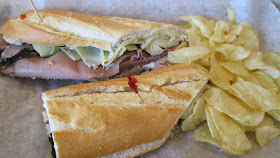OK…I admit it! I’m a little old fashioned and I’m not into today’s technology rage, especially when it comes to travel. I will use our Magellan to find addresses in cities and in especially populated and confusing areas. But in general…give me a good road map and I’m off on the back roads…exploring…looking for that next nifty place or out of the way attraction!
Before we headed out on our Florida trip, I checked out our possible return routes. We’d decided to just drive part way from Clearwater and then stop for the night on our return to our home in East Tennessee… We wanted to do a little sightseeing along the way. Looking on my map north from Clearwater, I decided that I would take US 19 north until I came to a road that would let me angle back to the northeast and I-75. Then I saw a place on the map that I’d always wondered about…an isolated cluster of keys, (islands)…on a parallel with Ocala, just offshore in the Gulf of Mexico.

This is the old downtown area of Cedar Key Florida. Cedar Key is a small town, population 707, located on 3 keys/islands named the Cedar Keys, just off the coast of Florida in Levy Country. (County’s population is less than 42,000) The whole town occupies only about 9/10 of a square mile and it sits 10 feet above sea level. Way Key is the largest of these island… Probably because of its isolated location, the town’s population has dropped by about 83 residents since the 2000 census.
In driving times, Cedar Key is 1 hour and 18 minutes (57 miles) southwest from Gainesville; 1 hour and 25 minutes (70 miles) west of Ocala, and; 2 hours and 48 minutes (128 miles) north of Clearwater.
This is the more crowded street along the waterfront… There are a number of restaurants, bars and shops along this thoroughfare. However, there is no way you could say that the town was packed with tourists. There were just enough visitors to drive some business and keep these establishments in business.
The Cedar Keys were first noted on a map by a Spanish cartographer back in 1542. In addition to the Spanish, several notable pirates, such as Jean Lafitte and Captain Kidd used the islands as a watering and rest stop. The islands were named for the Eastern Red Cedars which were once abundant in the area. Permanent occupation of the islands began in 1839 when General Zachary Taylor and US Army established a supply depot and hospital on Depot Key.
This is the Island Hotel & Restaurant. It was built in 1859 from seashell tabby with oak supports. The tabby walls are 10” thick and they’re supported by 12” beams. The building has survived hurricanes, flood and fire. For those who are interested in these things, the building is also reputed to be haunted…
The Island Hotel’s history is very interesting…and quirky too! For more detail about this establishment and its history, just go to http://islandhotel-cedarkey.com/history.html. This building is listed in the National Register of Historic Places.
This is a view across the harbor of Cedar Key towards the only sizeable condo complex that we saw during our visit.
This harbor became an important port in the mid-1800’s. The primary cargo was lumber and naval stores harvested from the mainland. By 1860, 2 mills on Atsena Otie Key were producing cedar slats for shipment to northern pencil factories. By 1860, Cedar Key became the western terminus for the Florida Railroad, connecting it to Fernandia Beach on the east coast.
This is a view back toward Way Key from one of the other keys that comprise the town. The town offers a laid back atmosphere, a number of good but very casual restaurants, lots of fishing opportunities and plenty of sunshine.
The Confederate Army occupied the islands until early 1864 and it was an important source of salt for their forces. The town of Cedar Key was incorporated in 1869 with a population of 400 residents. When Tampa received rail service in 1886, the shipping business and the economy in Cedar Key began a long decline.
There are plenty of opportunities to rent homes or cottages in Cedar Key. Laurie and I will be looking into that possibility over the next several months. The views of the keys and the Gulf of Mexico are very relaxing…
Another historical note... Naturalist John Muir walked 1,000 miles from Louisville Kentucky to Cedar Key in just 2 months in 1867. He contracted malaria while working in a saw mill in the Keys and was nursed back to health in the house of the mill’s superintendent. He sailed from Cedar Key to Cuba in 1868.
This is the George T. Lewis Airport on one of the other populated keys. It has a 2,355 foot runway…no facilities…sea gulls on the runway, (also used as a public road)…and it handles an average of 77 private planes per week.
Here’s a photo of the airport that was taken by a private pilot… This is not exactly like O’Hare in Chicago!
One more view of the keys… Cedar Key has been beaten up repeatedly by Hurricanes over the years. In 1896, a 10 foot storm surge killed 100 residents and, between the surge and the 125 mile an hour winds, the remaining juniper trees and the mills were destroyed. In 1950, another hurricane destroyed 2/3 of the homes in the keys.
Cedar Key was like a breath of fresh air to us… Our visit was brief but we liked what we saw! In the near future, I’ll be publishing a blog about our dining experience in Cedar Key…and it was a good experience…
Just click on any photo to enlarge it…
Thanks for stopping by and sharing this hidden corner of America with us!
Take Care, Big Daddy Dave


















































